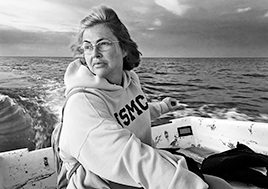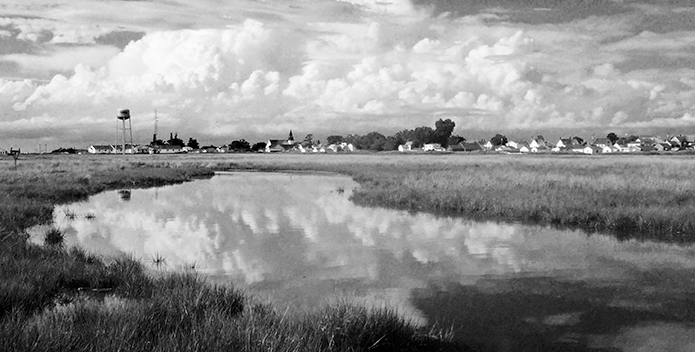On Thursday, November 15, CBF is thrilled to host author Earl Swift as he discusses his recent book Chesapeake Requiem: A Year with the Watermen of Vanishing Tangier Island. Swift spent roughly two years living in the watermen community on Tangier Island, a 1.3-square-mile spit of land in the center of the Chesapeake Bay. Often called the softshell crab capital of the world, Tangier's surrounding waters are integral to its way of life. But the very water that has long sustained Tangier now erases the island day by day, wave by wave, as the island sinks and the Chesapeake rises. Joined by prominent lifetime Tangier residents and watermen, Cook Cannon and Ooker Eskridge, Swift will discuss with the group Tangier's past, present, and tenuous future. In eager anticipation of this evening discussion, we’re offering a bit of a preview below of the powerful story courtesy of HarperCollins Publishers.
From CHESAPEAKE REQUIEM: A Year with the Watermen of Vanishing Tangier Island, by Earl Swift, published by Dey Street. Copyright 2018. Reprinted courtesy of HarperCollins Publishers.
INTRODUCTION
A day after the storm passed, Carol Pruitt Moore climbed into her skiff and set off for the ruins of Canaan.
It was her habit to strike west from the harbor, into the channel that split her island in two. She'd throw open the throttle and crouch forward as the boat's nose came up and its stern dug deep, her six-foot frame rocking against swells that thudded the fiberglass hull. One hand on the tiller, ball cap pulled low to cheat the wind, she would speed past the county dock and twenty-odd workboats parked off to port and, to starboard, a ragged line of crab shanties—weather-scoured sheds perched on stilts a few feet over the drink, surrounding decks stacked high with wire-mesh crab pots. A watery little business district, home to the greatest fishery of its kind in the world.
Out past the last of the shanties, the channel opened into the Chesapeake Bay, and most every day she threw the boat into a banking turn to the north. This time of year, she was running afoul of the prevailing winds, and if they were blowing against the tide, the journey would not be smooth. But like most of her neighbors, Carol Moore had been born into a seafaring family: She was the eighth generation of her kin born on Tangier Island, sixteen open-water miles from the nearest mainland town in Virginia. She could handle a boat before she could read.

Carol Moore is an eighth generation Tangier Islander, she could handle a boat before she could read.
Earl Swift
On a typical afternoon she'd hug the edge of a treeless, uninhabited marsh that islanders call Uppards, until a mile along she reached Tangier's northern tip, where a century past a community thrived. Canaan had long since washed away, but she found sanctuary on the deserted beach there, an escape from the close quarters and relative bustle of town. And more: She came upon tiny bottles once filled with patent medicines, offered by visiting drummers to island women a hundred years dead—Hamlin's Wizard Oil, a nineteenth-century tonic for cancer, quinsy, and "bites of dog," and Greene's Infallible Liniment, a cure-all "For Man or Beast," and Turlington's Balsam of Life, said in its day to cure kidney stones and "inward weakness." She found eighteenth-century clay pipes and headless porcelain dolls. She collected bits of crockery, edges tumbled smooth by the surf.
Each relic she plucked from the sand was a tangible link to her forebears, for her father's people had lived at Canaan for generations, back when it had its own school and a general store and thirty-odd houses, and had stayed until the last holdouts quit the place. By the time she was born, in 1962, that abandonment was decades passed, and none of Canaan's buildings remained. But on childhood visits she had seen chickens and goats still roaming loose there, along with thickets of wild rose and rhubarb and so much anise that the whole place smelled like licorice. She remembered, too, walking deep into the marsh with her father, weaving among water bushes to a small cemetery far from the water. Its simple marble headstones testified to the lives of good Christians, loyal wives, hardworking watermen.
Here was where her great-grandparents had passed their days, and their parents, and theirs—people who persisted in her blood, her looks, her habits and manners. Here lay reminders of what she would become, and of the impermanence of all things. Some days she spent hours there, walking the water's edge. Others she stayed for just minutes. Almost always, she left for home feeling more sturdily, steadily grounded.
Only this afternoon promised to be different. For the previous three days, Tangier had been raked by Hurricane Sandy, its winds blowing a steady fifty knots or better, gusting past seventy. The gale had conspired with the tides to swamp the place. White-capped waves had rolled in from the east, breaking over streets and into homes. Water had surged through the channel, sweeping away anything not anchored firm. At high tide, only a few knobs of high ground and a single humpbacked bridge had escaped the flood.
Now, with the air scrubbed clean, whatever caught Moore's eye revealed itself in preternatural detail. A few crab shanties had been flattened, and even from a distance their staggered plywood showed off its grain, and the wounds in their smashed planking gleamed a sunny, surreal yellow. Crab pots were strewn in the shallows. Pieces of roof and pier lay twisted among the reeds at the water's edge. Skiffs were sunk to their gunwales.
She sped into the bay. It was a sunny afternoon, cloudless, the sky a deep and flawless blue, the water flat—"slick calm," as the watermen say, which leaves Tangier lips as slick cam. Back in town trees were down, yards lay piled with trash that the tide had lifted from the marsh, and families were dragging ruined furniture and carpeting outside; to experience such peace out here, just hours after the storm's mayhem, seemed unreal.
Sure enough, when she rounded the island's northern tip, she saw that the gale had not spared Canaan. The shoreline had been broken into pieces, cleaved by three new channels. Much of the sand that she'd walked for years had been ripped away, and minus this protective buffer, the Chesapeake now lapped against the dark sod in which the island's marsh grass was rooted. The soil crumbled with each pulse.
She motored along the water's edge until she found a place to land the boat, and as she scrambled out she noticed something a foot or two offshore: a stained brown sphere half submerged in maybe six inches of water, rocking gently with the push and pull of the waves. As she stepped nearer she saw there were two of them. After a moment's hesitation she bent down for one, and came up with a human skull.
It was well preserved, its hollows rinsed clean by the agitation of the surf. That of an adult, it appeared—though all of its upper teeth were missing and its lower jaw, too, so it was hard to reckon much beyond that. She rescued its mate, finding it in similar condition, and rested both on the ground well above the tide line.
She was struggling to digest her discovery when her eyes fell on a succession of familiar shapes at her feet—a rib cage first, then clavicles, then a pelvis and all the other components of a human skeleton, down to the tiniest bones of the toes. The remains lay faceup in bas-relief, topmost inch exposed, the rest still encased in clay. Around them lay the traces of a coffin, and around that, a sharp-edged rectangle cut into the earth: a grave.
And lo, a few feet away was a second grave, and in it a second complete skeleton, likewise only partially exposed, with hair combs held fast by the clay on either side of its skull. And beyond that, a third grave, containing a tiny casket inside a bigger coffin, and nested in the middle the skeleton of a small child, perhaps no more than a toddler. Its shroud had long since succumbed to rot, but two bright white buttons that had held the garment closed were aligned on the child's breastbone.

Earl Swift spent most of two years living with the watermen of Tangier Island.
Saylor Denney
Carol Moore looked around her and saw that she stood among a half dozen additional graves arranged in a haphazard cluster at the water's edge. A fourth complete skeleton occupied one. Others were a jumble, their contents stirred by the surf. A spine lay topside. Shin bones. A mandible. And a few yards away lay white marble head- stones, those she remembered seeing as a youngster. In the forty years since, the bay had chipped away at the shoreline, had little by little stolen the ground under Canaan, until a quarter-mile of island was gone.
Skip ahead to a clear, breezy afternoon four years later. I'm at Uppards combing the clay shoreline and struggling to picture the Canaan of years gone by—a stretch, for it "got drownded," as Tangiermen say, and is now on the bay's bottom a fair piece offshore. Crabs scuttle over the vegetable gardens that nourished the place, the foundations of its homes, whatever remains of the school that doubled as its Methodist meetinghouse.
Actually, it was underwater years before Carol Moore's macabre discovery on Halloween 2012, just after Sandy passed on its way up the Atlantic coast; the graveyard, after all, was hundreds of feet farther inland than Canaan itself. Now the graves she stumbled upon are well out to sea, too.
But what the bay has stolen, it returns in pieces: Stranded by the last high tide are square handmade nails and rusted bits of machinery, shards of china rimmed in blues and pinks, and the roots of trees that once shaded Canaan's homes. I collect a nail, the neck of an ancient ice-blue bottle, and a wave-worn knot of tree limb, stepping around headstones that every few weeks Carol has dragged clear of the advancing water. In loving memory of Polly J. Parks, who died in December 1913, age thirty-seven. Nellie A., beloved daughter of S. E. and Eva I. Pruitt, buried before her second birthday. Margaret A. Pruitt, born in 1836, gone in 1901.
I consider the stones for a long moment, wondering whether the people bearing those names ever imagined that the bay would one day claim all but these scant traces of their existence—that it would plunder their homes, their entire village, then come for what remained of them. Doubtful, I decide. The Chesapeake had been stealthy here.
The Pruitts and Parkses might scarcely have noticed the waves nipping at the land's edges, carrying off a few grains here, another few there. It wasn't until these three were dead and buried that the cumulative effects of those tiny incursions became plain: that half an inch a day added up to more than a foot a month. That in a year, a merciful year, the water drew fifteen feet closer. That eventually came a dawn when it pushed at the door.
So it went all around Tangier Island; so it continues. From where I stand, I can see Tangier proper across the marshy expanse of Uppards—the steep roofs of weather-boarded homes bunched along lanes not much wider than sidewalks; the spire of Swain Memorial United Methodist Church, for generations the island's cultural and spiritual centerpiece; and, hovering above, a sky-blue water tower decorated with a giant orange crab on one side, a cross on the other.
It is a community unlike any in America. Here live people so isolated for so long that they have their own style of speech, a singsong brogue of old words and phrases, twisted vowels, odd rhythms. Its virtually amphibious men follow a calendar set by the Chesapeake Bay blue crab, and they catch more of the prized delicacy than anyone else. It is a near-theocracy of old-school Christians who brook no trade in alcohol, and kept a major movie from filming in their midst over scenes of sex and beer. And not least, this is one big extended family: All but a few islanders can trace their lineage to a single man.
For 240 years they've occupied a speck of mud and marsh that nowhere reaches more than five feet above the tide, seldom tops three, and most often fails to clear one. Now it is washing ever faster into a bay on the rise. What's more, the island is slumping, actually subsiding into the earth's crust. Full moons pull water not only over its edges, but straight up through the ground, turning yards into ponds. In fact, the lower Chesapeake's relative sea-level rise—the one-two punch of water coming up and land going down—is among the highest on Earth, and of all the towns and cities situated on the estuary, none is as vulnerable, none as captive to the effects of climate change, as Tangier.
Near the water's edge I find a silvery metal bracket perhaps two inches long and shaped into a scroll, like the head of a violin. I have no clue what it might be. Carol Moore is scanning the shore about fifty yards away, and I carry my find to her. She identifies it with the briefest of glances: "That's from a casket."
A few minutes later, examining a tidal pool in the sod, I find what appears to be an interesting piece of driftwood. It's pale gray, four inches long, and resembles a tree stump in miniature. It feels featherweight, leached of substance, and I see that it's laced with tiny holes.
With a jolt, I realize it's bone.
I gently return it to the ground.



